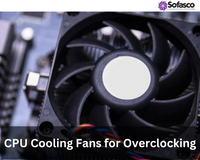In today's digital landscape, where businesses rely heavily on data-driven operations. The importance of data center performance and reliability cannot be overstated. Data centers serve as the backbone of organizations, housing critical infrastructure and storing vast amounts of data. However, ensuring optimal data center operation goes beyond just hardware and storage—it also hinges on effective cooling strategies. Cooling plays a pivotal role in optimizing data center performance and reliability, as it directly impacts equipment functionality and longevity.
In this blog post, we will explore the maximizing data center performance and reliability by exploring the key role of cooling strategies in achieving optimal operation. By understanding the significance of cooling and implementing effective strategies, businesses can unlock the full potential of their data centers while ensuring uninterrupted and reliable operations.
Understanding the Importance of Cooling in Data Centers
Cooling is a critical aspect of data center operations as it plays a vital role in maintaining the optimal operating conditions for the electronic equipment housed within. Data centers generate a significant amount of heat due to the high density of servers, storage systems, networking equipment, and other hardware components that are constantly running. Efficient cooling is essential to prevent overheating, ensure reliable performance, and protect the valuable data stored in these facilities. Here are some key reasons why cooling is important in data centers:

- Temperature Regulation: Electronic devices are designed to operate within specific temperature ranges. Excessive heat can cause components to malfunction or fail, leading to system downtime, data loss, and increased hardware replacement costs. Cooling systems help maintain a consistent and suitable temperature within the data center environment to ensure optimal performance and reliability.
- Equipment Longevity: Overheating is one of the main causes of premature hardware failures. By keeping the temperature within the recommended range, cooling systems help extend the lifespan of critical equipment, reducing the need for frequent replacements and minimizing associated costs.
- Energy Efficiency: Efficient cooling infrastructure and cooling management strategies contribute to energy savings and cost reduction. By utilizing advanced cooling technologies, such as liquid cooling or hot/cold aisle containment, data centers can achieve better energy efficiency and minimize their environmental impact.
- Capacity Optimization: Effective cooling enables data centers to maximize their computing capacity. When cooling systems are properly designed and implemented, it allows for higher server densities, more efficient space utilization, and increased scalability. This optimization translates into better resource utilization, improved productivity, and the ability to meet growing data processing demands.
- Redundancy and Resilience: Cooling systems are a critical component of the overall redundancy and resilience planning in data centers. Redundant cooling infrastructure, such as backup cooling units and redundant piping, ensures that cooling is maintained even in the event of equipment failures or power outages. This redundancy helps minimize the risk of downtime and ensures continuous operation.
- Environmental Considerations: Cooling systems in data centers have a significant impact on the environment due to their energy consumption and associated carbon emissions. Implementing energy-efficient cooling technologies and practices not only reduces operational costs but also contributes to sustainability goals by minimizing the carbon footprint of data centers.
Cooling Strategies for Maximizing Data Center Performance
To maximize data center performance, it's crucial to implement effective cooling strategies that optimize temperature regulation, energy efficiency, and overall system reliability. Here are some key cooling strategies commonly employed in data centers:
- Hot/Cold Aisle Containment: Hot/cold aisle containment is a popular strategy that involves separating hot and cold air streams to minimize the mixing of air. In this approach, server racks are arranged in alternating hot and cold aisles, and barriers or doors are installed to contain and direct the airflow. By keeping hot and cold air separate, this strategy improves cooling efficiency and reduces energy consumption.
- Precision Air Conditioning: Precision air conditioning systems equipped with cooling fans and blowers provide targeted cooling directly to the equipment in the data center. These systems utilize advanced temperature and humidity controls along with high-performance cooling fans to maintain precise environmental conditions.
- Liquid Cooling: Liquid cooling systems employ various components, including cooling fans and blowers, to circulate coolants or chilled liquids in direct contact with heat-generating components. Cross-flow fans are commonly used to enhance heat transfer in liquid cooling setups, ensuring efficient cooling of high-density equipment.
- Free Cooling: Free cooling leverages naturally cool external air or water sources to supplement or replace mechanical cooling systems. It involves using air-side or water-side economizers to cool the data center without relying solely on energy-intensive air conditioning units. By taking advantage of favorable outdoor conditions, free cooling can significantly reduce energy consumption and operational costs.
- Computational Fluid Dynamics (CFD) Analysis: CFD analysis involves using sophisticated simulations to model and optimize airflow patterns and heat distribution within the data center. By identifying potential hot spots, airflow obstructions, or inefficiencies, CFD analysis can guide the design and placement of cooling infrastructure for optimal cooling performance.
- Monitoring and Automation: Implementing comprehensive monitoring systems allows data center operators to continuously track temperature, humidity, and airflow patterns in real-time. By using sensors and intelligent automation, cooling systems can be dynamically adjusted to match the actual heat load, ensuring that cooling resources are efficiently allocated and eliminating unnecessary energy consumption.
- Efficient Rack Layout and Cable Management: Proper rack layout and cable management practices play a crucial role in optimizing cooling. Well-organized racks with appropriate spacing between equipment allow for better airflow, reducing hot spots. Additionally, effective cable management prevents the obstruction of airflow and facilitates easier access for maintenance, enhancing overall cooling efficiency.
- Redundancy and Backup Cooling: To ensure resilience and minimize the risk of downtime, redundant cooling systems and backup solutions should be in place. Redundant cooling units, power supplies, and backup generators provide failover capabilities, ensuring that cooling is maintained even during equipment failures or power outages.
Continuous monitoring and optimization are essential for identifying areas of improvement and ensuring the cooling infrastructure is functioning optimally. By employing these strategies, data center operators can enhance reliability, extend equipment lifespan, and optimize operational costs in an ever-evolving digital landscape. At Sofasco specializes in designing and manufacturing industrial cooling fans in varied specifications. Get in touch with their team to know more about these industrial fans.












